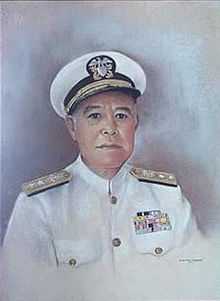Gordon Chung-Hoon
| Gordon Paiʻea Chung-Hoon | |
|---|---|
 Admiral Chung-Hoon | |
| Born |
July 25, 1910 Honolulu, Hawaii |
| Died | July 24, 1979 (aged 68) |
| Allegiance |
|
| Service/branch |
|
| Years of service | 1934–1959 |
| Rank |
|
| Battles/wars | World War II |
| Awards |
Navy Cross Silver Star |
Gordon Paiʻea Chung-Hoon,[1] (Honolulu, Hawaii, July 25, 1910 – July 24, 1979) was an admiral in the United States Navy, who served during World War II, and the first Asian American flag officer. His father, William Chung-Hoon Jr., a Chinese-English-Hawaiian,[2][3] was a county treasurer and his mother Agnes Punana, a Hawaiian, was a member of the Kaahumanu Society. He graduated from Punahou School in 1929.
Biography
Military career
He attended the United States Naval Academy and graduated in May 1934, becoming the first Asian American, U.S. citizen graduate of the academy.[4] While a student he gained national prominence as the football team's halfback and punter, and in 1934 starred on the team that broke an 11 year winless streak against the Army team.[5] He is a recipient of the Navy Cross and Silver Star for conspicuous gallantry and extraordinary heroism as commanding officer of USS Sigsbee from May 1944 to October 1945.[1]
In the spring of 1945, Sigsbee assisted in the destruction of 20 enemy planes while screening a carrier strike force off the Japanese island of Kyūshū. On April 14, 1945, while on radar picket station off Okinawa, a kamikaze crashed into Sigsbee, reducing her starboard engine to five knots and knocking out the ship's port engine and steering control. Despite the damage, then Commander Chung-Hoon kept his antiaircraft batteries delivering "prolonged and effective fire" against the continuing enemy air attack while simultaneously directing the damage control efforts that allowed Sigsbee to make port under her own power.[1]
Post-military
He retired in October 1959 as a rear admiral. He was appointed to be the Director of Hawaiian Department of Agriculture,[6] and died in July 1979.[7]
Namesake
The Arleigh Burke class destroyer USS Chung-Hoon is named for him.[8]
References
- ↑ 1.0 1.1 1.2 William Cole (September 16, 2004). "USS Chung-Hoon at home in Pearl Harbor". Honolulu Advertiser. Retrieved October 22, 2009.
- ↑ JO1 Daniel J. Calderón (20 September 2004). "Chung-Hoon Commissioned". Navy Region Hawaii Public Affairs. United States Navy. Retrieved 19 June 2011.
The commissioning ceremony paid homage to Adm. Chung-Hoon’s combined Chinese and Hawaiian ancestry.
- ↑ William Cole (16 September 2004). "USS Chung-Hoon at home in Pearl Harbor". The Honolulu Advertiser. Retrieved 19 June 2011.
Chinese, Hawaiian and English ancestry.
- ↑ Gelfand, H. Michael (2006). Sea change at Annapolis: the United States Naval Academy, 1949-2000, Volume 415. UNC Press. p. 48. ISBN 0-8078-3047-X. Retrieved September 2, 2009.
- ↑ Jack Clary (October 19, 2008). "Navy To Play Its 1200th Football Game Saturday Against SMU". Navysports.com. CBS Interactive. Retrieved October 22, 2009.
- ↑ AsianWeek Staff (8 July 2009). "Gordon Pai’ea Chung-Hoon". Chinese American Heroes. AsianWeek. Retrieved October 22, 2009.
- ↑ Lt. j.g. James McLeod (September 10, 2004). "Chung-Hoon arrives today". Hawaiʻi Navy News. Retrieved October 22, 2009.
- ↑ Journalist 1st Class Daniel J. Calderón (September 20, 2004). "Chung-Hoon Commissioned". Navy NewsStand. Retrieved October 2009.
External links
- United States Navy biography
- "Lest We Forget", By Lieutenant Commander Thomas J. Cutler & Arthur D. Baker III. Proceedings, November 2004